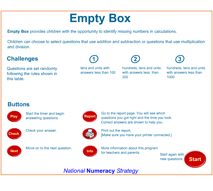Consolidation and practice
These resources are to support children in guided or independent work. Roll over the highlighted resource for a description.
Empty box program

This ICT-based tool can be used by children to practise and consolidate multiplication, division, addition and subtraction, and to develop understanding of inverse operations and when not to use a calculator. Different activities, numbers of questions and operations can be selected to vary the level of challenge.
Opportunities to use and apply
Possible contexts include:
- Word problems, e.g. A pencil weighs about 3 g. A school buys 135 packs of 12. Approximately how much will these weigh in kg?
- Money problems, e.g. How many notebooks costing £1.65 is it possible to buy with £50?
- Data handling, e.g. Finding the mean of a set of data.
Confirming learning
Decide which of these problems you would solve using a calculator.
Explain why and solve those problems:
- A runner runs the 100 m four times. His times are: 11.25 s, 11.69 s, 10.8 s and 12.13 s. Find his average time.
- A film starts at 4:25 pm and ends at 6:05 pm. How long is it?
- 0.09 ×
 = 0.72
= 0.72
- Find a number n such that n × (n+1) = 1332
- Elena has a £50 budget to spend on a garden. She buys 18 packets of seeds costing £1.49 each, a spade costing £7.99 and a hose costing £12.49. How much money does she have left?
- I buy a sheet of stamps. On the sheet there are 18 rows each containing twelve 35p stamps. How much will this cost?
 + 85 = 1
+ 85 = 1 3
3 = 1110
= 1110 Calculating
Calculating
